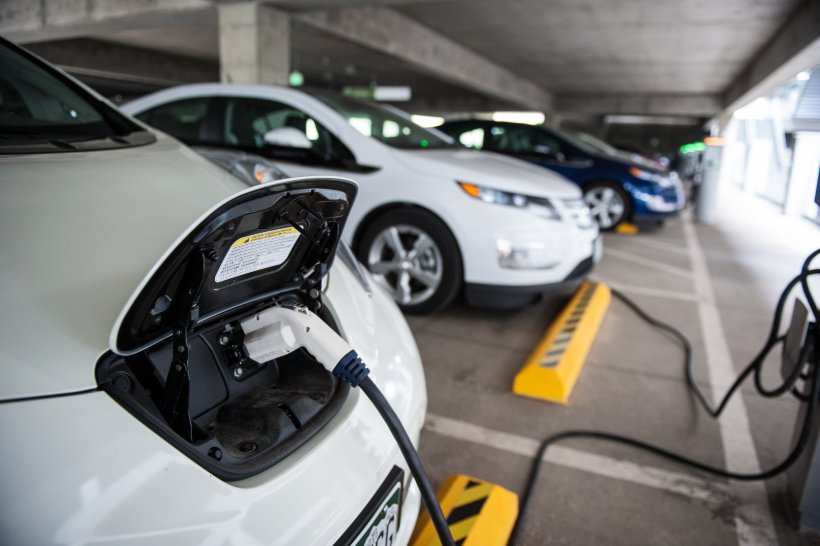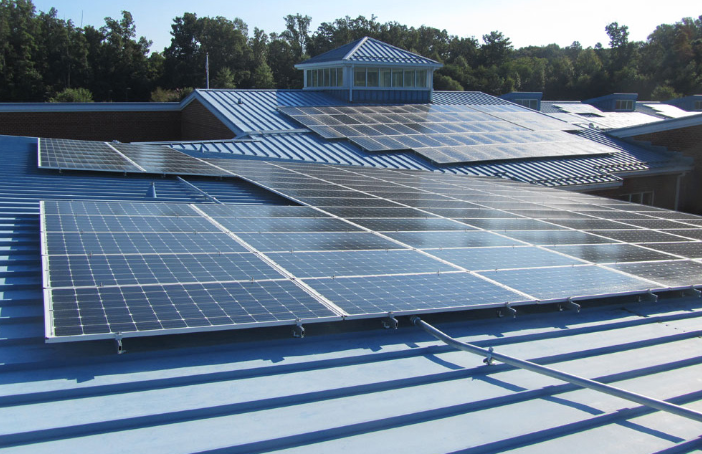Jul 28, 2021
What Direction Should Solar Panels Face? Probably South, but It Depends.
If Your School, Hospital or Business is Planning to Go Solar, Make Sure that Your Solar Company Has a Good Plan for Positioning Solar Panels on Your Roof, Parking Canopy or Ground Mount
In the last couple years, installing a solar energy system on site has become more and more popular for homeowners and commercial solar customers like schools and businesses alike.
We know we’re biased, but our customers tell us they have good reasons to go solar. They save money on their electric bills, which can make a big difference, especially if they use a lot of power. Going solar also elevates an organization’s reputation in their community by showing that they’re doing something serious to go green (something that goes far beyond recycling).

Then there are electric cars, coming soon to a garage or parking lot near you.
In the last few months, some of our customers have started thinking of joining the electric vehicle revolution, which seems to be coming now quicker than anybody predicted. Whether you’re a small business trying out your first all-electric company car or a school district starting to build a fleet of electric school buses, going solar now will put you in the driver’s seat to save even more money when you plug in your first EV. And you can go even deeper green by powering your EVs with clean energy from the sun, instead of mostly dirty energy from the grid.
Our customers also tell us that they did their due diligence before deciding to work with Secure Futures. And that’s how it should be. Because if you choose the wrong company to install your solar array, you could be in for unwelcome surprises.
Believe it or not, we’ve seen rooftops covered in so many solar panels that they actually produce less power than they would with fewer panels. Ouch. We’ve also heard about systems where the panels were installed facing north. That would be OK – if you’re located in Australia. But it’s not OK if you’re in the continental U.S. or anyplace else located north of the Equator.
A skilled, reputable solar developer or installer is best qualified to develop a plan to build out your solar energy system to maximize the power you produce at the lowest cost. So, you don’t need to know the technical details of how to place and orient solar panels in their racking. But you should know a few basics to double check what you hear from your solar professional.
To help you judge whether a solar company is providing you with the best counsel, we offer a quick guide below of three things you should ask about how your solar panels are going to be installed: the direction the panels will face, the tilt of the panels and how far apart they’re spaced from other panels.
1. Solar Panels Facing South Maximize Solar Energy Production – Usually

Did you know that the amount of sunlight that strikes the earth’s surface in an hour and a half is enough to handle the entire world’s energy consumption for a full year? If you live in the Northern Hemisphere, this can be done best by facing your panels south to achieve the most savings over any other direction.
If you are north of the tropics, the sun will range from being directly overhead to over parts of the earth that are farther south. This means that facing your panels southward exposes them to the most amount of sunlight per area possible and will result in the highest potential electricity production. That may be obvious to some, but the basic equation is this:
The more sunlight reaching each panel = the more solar energy is produced
And even though the sun changes its position in the sky depending on the season, installing a solar system that faces south lets the panels absorb the most sunlight all year long. In general, panels facing directly east or west will produce about 20 percent less electricity, and so south is the best direction for year-round solar productivity.
But while a southward-facing system is the best for most situations, it is important to note that it can be profitable to collect either more or less sunlight at certain times during the day. This is because of Time of Use (TOU) Pricing, or peak-demand charges that electric utilities may assess on top of their normal rate to encourage customers to use less power at times other customers are using more.
Why do you need to consider your peak demand charges when deciding on which way to install your solar array? Because you will likely pay a higher rate for your electricity at “coincident peak” times, meaning utilities can profit more when charging for electricity as overall grid consumption rises and less when demand is lower.
Because your panels will generate more electricity from the sunlight depending on where you are, the sunlight will move throughout the day and your panels will have more sunlight at one time and less at others. For example, if you turn your panels to the east, they will take in more electricity in the morning because the sun moves east to west. But if you face your panels to the west then you will take in more electricity in the mid to late afternoon.
The cardinal direction that you decide to turn your solar panels towards the sun will have a direct impact on your money savings, which is why some customers use movable solar panels that track the sun over the changing course of the seasons of the year. Even more sophisticated tracking systems allow solar panels to follow the as it changes position in the sky over the course of a day.
2. Tilting: The Perfect Angle Doesn’t Exist

Yep, we said it. Tilting solar panels at an angle can allow them to collect even more sunlight than if the panels are laid flat on their racking. But the perfect angle at which to tilt your solar panel does not exist. This is because every solar installation is different, and each one is based on a multitude of factors that the solar installer or developer configures for you to benefit from the most savings.
The angle of tilt generally increases when the latitude increases. The farther your location is from the Equator, the higher the angle of your array should be. For example, states located in the southern part of the United States like Georgia or Arizona, at lower latitudes, will experience the sun higher in the sky and will need a lower tilt to capture this direct sunlight. Conversely, the higher the installation is in latitude, such as in New York state or Oregon, the higher the tilt will have to be. The Mid-Atlantic area where most of our customers are located sits somewhere in the middle.
Because the sun not only moves during the day, but also changes its path every season, the general rule is to subtract 15 degrees from the latitude at your location during the summer months and add 15 during the winter. This means if you wanted to get the maximum productivity from your panels all year round, you will have to adjust them each season.
Again, that’s where a tracking system comes into use. But these systems add additional complexity, which may outweigh the benefit of the extra sun they are able to catch. A good solar company can help you decide whether a tracking system makes sense at your location.

3. Spacing Makes All the Difference
Got space? Spacing your panels properly is almost as important as the facing them in the correct direction.
When spacing your panels, on the one hand, they need to be close enough together so that you can maximize the surface area available. On the other hand, they need to be far enough apart so they do not shade each other when the sun naturally moves throughout the day.
If any part of a solar panel is shaded, it is not able to consume the direct sunlight that will turn into energy. It’s just like having your solar panels shaded by a tree or a neighboring building that’s too close and too tall. Any kind of shadow will reduce the productivity of solar panels. Since solar panels produce more power as more photons hit their surface, the ideal level of shading for a solar panel is zero. You want an unobstructed path from the sun to the solar panel every hour of the day and every day of the year. It’s very simple.
Correct spacing also depends on the angle or tilt of your panels, as the higher the tilt, the steeper the panels are placed and the longer shadow they can throw.
To get the most bang for your buck might not mean covering every inch of your roof with panels. Even when it comes to solar panels, there can be too much of a good thing.
Solar installers know that they shouldn’t cram rows of solar panels so close together that one row will throw shade on the row in front or behind it. But some solar companies are more focused on how much profit they’ll make from selling more solar panels than they are on trying to maximize their customer’s return on investment.
When a solar company puts its own interest ahead of its customer’s interest, the customer will pay more.
No matter how your solar power system is financed, solar panels aren’t free. If you get too many of them, you’ll pay one way or the other, whether through a higher initial cost to purchase equipment, higher lease payments, or a higher monthly rate for a power purchase or service agreement.
Secure Futures takes a different approach. Since we are dedicated to giving our customers the highest solar production at the least cost, our motto is buy solar power, not solar panels: more panels does not necessarily mean more solar.
The Trick: Find a Good Solar Developer or Installer
As a solar developer who plays a role in the ongoing performance of any photovoltaic system we install for the next 20 or 30 years, it’s in our own interest to provide customers with solar installations that have been calculated, tested, and proven to lead to maximum energy production, and maximum energy bill savings.
Now that you know to consider which direction a solar panel needs to face, at which angle it needs to be placed and how far it should be spaced from other panels, you can make a good decision when picking a solar installer or developer to help you join the clean energy revolution. Any good solar installer will know how to find the savings sweet spot and will not just try to cover your entire roof with panels, tilted as high as they’ll go – and especially not facing north.